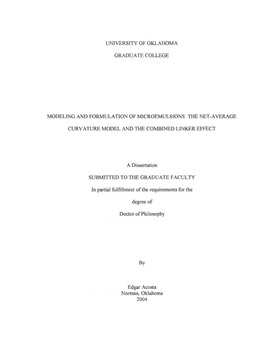| dc.contributor.advisor | Harwell, Jeffrey H., | en_US |
| dc.contributor.author | Acosta, Edgar. | en_US |
| dc.date.accessioned | 2013-08-16T12:19:19Z | |
| dc.date.available | 2013-08-16T12:19:19Z | |
| dc.date.issued | 2004 | en_US |
| dc.identifier.uri | https://hdl.handle.net/11244/695 | |
| dc.description.abstract | Microemulsions are phases that contain both oil and water which coexists in thermodynamic equilibrium due to the presence of surfactant films that segregate at the oil - water interface. These systems can be used in numerous applications, including enhanced oil recovery, remediation of oil-impacted aquifers, nanoparticle synthesis, drug and cosmetic delivery and cleaning systems. The thermodynamic properties of microemulsions are dictated by the properties of the surfactant membrane such as curvature, characteristic length and rigidity. The goal of this work was to understand the role of surfactant, linker molecules and formulation conditions (e.g. electrolyte concentration, temperature, additive to surfactant ratios, etc.) on the curvature, characteristic length and rigidity of surfactant membranes in microemulsions. Chapters 2 and 3 describe a critical scaling model of surfactant membrane curvature called the net-average curvature that was able to reproduce the phase behavior of surfactant systems, including solubilization, droplet size, phase transitions, phase volumes and interfacial tensions. Three important parameters are essential to this model: the extended length of the surfactant tail, the characteristic length, and the interfacial rigidity. Chapter 4 studies the effect of adding hydrophilic and lipophilic linkers on the characteristic length of microemulsion systems, and how the interfacial rigidity influences the dynamic behavior of microemulsions. Chapter 5 extends the concept of linker formulations for a wide variety of oils and studies the performance of these systems in oil removal from porous media and from textiles. Chapter 6 attempts to elucidate how hydrophilic and lipophilic linkers self-assemble at the surfactant membrane and introduce the concepts of critical microemulsion concentration. Chapter 7 studies how to use linker molecules to formulate non-toxic microemulsion systems. Chapter 8 provides a summary of the results and conclusions obtained in this research. | en_US |
| dc.format.extent | xviii, 308 leaves : | en_US |
| dc.subject | Solubilization. | en_US |
| dc.subject | Emulsions. | en_US |
| dc.subject | Chemistry, Physical. | en_US |
| dc.subject | Hydrophile-lipophile balance. | en_US |
| dc.subject | Engineering, Chemical. | en_US |
| dc.subject | Surface active agents. | en_US |
| dc.title | Modeling and formulation of microemulsions: The net-average curvature model and the combined linker effect. | en_US |
| dc.type | Thesis | en_US |
| dc.thesis.degree | Ph.D. | en_US |
| dc.thesis.degreeDiscipline | School of Chemical, Biological and Materials Engineering | en_US |
| dc.note | Major Professor: Jeffrey H. Harwell. | en_US |
| dc.note | Source: Dissertation Abstracts International, Volume: 65-01, Section: B, page: 0317. | en_US |
| ou.identifier | (UMI)AAI3120034 | en_US |
| ou.group | College of Engineering::School of Chemical, Biological and Materials Engineering | |
